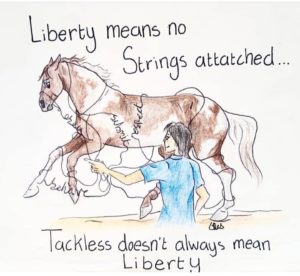I saw this drawing on Instagram the other day. I don’t know where it originated, but I love it!
 (If you know who the artist is, please let me know so I can give credit!)
(If you know who the artist is, please let me know so I can give credit!)
I’ve really found working with my horses at Liberty a valuable tool. But when I say liberty, I mean the horse is free to make the choice, and that’s where the value lies. If they don’t choose to participate in what I’m doing, that gives me a lot of information about how comfortable they are, and how rewarding they find whatever it is I’m doing with them. Then it’s my job to find another way to become more engaging and rewarding, or to make them more at ease, so they DO want to play with me. If they walk away from me, then I know they’re comfortable to do so. It’s a good thing, certainly not something to be discouraged by chasing or correction.
There are a couple things that are sometimes called “liberty training” that I don’t include in my definition.
First, chasing a horse around to frighten or encourage them into an expressive trot is not liberty training. Yes, there are horses who love liberty class at the show, and that’s great. It’s a fun opportunity for them to get out of their stall and blow off steam, but it’s not training. It’s a bit of fun for the horse who enjoys it, and either tedious or frightening for those who don’t.
Second, and much more importantly, a horse who has no tack on, but doesn’t feel like he has any choice but to do as he is told, is not at liberty. Skills that are taught using tack or whips or other forms of restriction, and enforced through threat of consequences, are not liberty training, even when the tack is removed.
Liberty means choice.
Liberty means communication.
Liberty means freedom.
True liberty training improves your relationship with your horse, not your control over them.
Want to learn more? Liberty Basics
Love this